How to Get Your WordPress Content Cited by AI Tools (My Expert Tips)
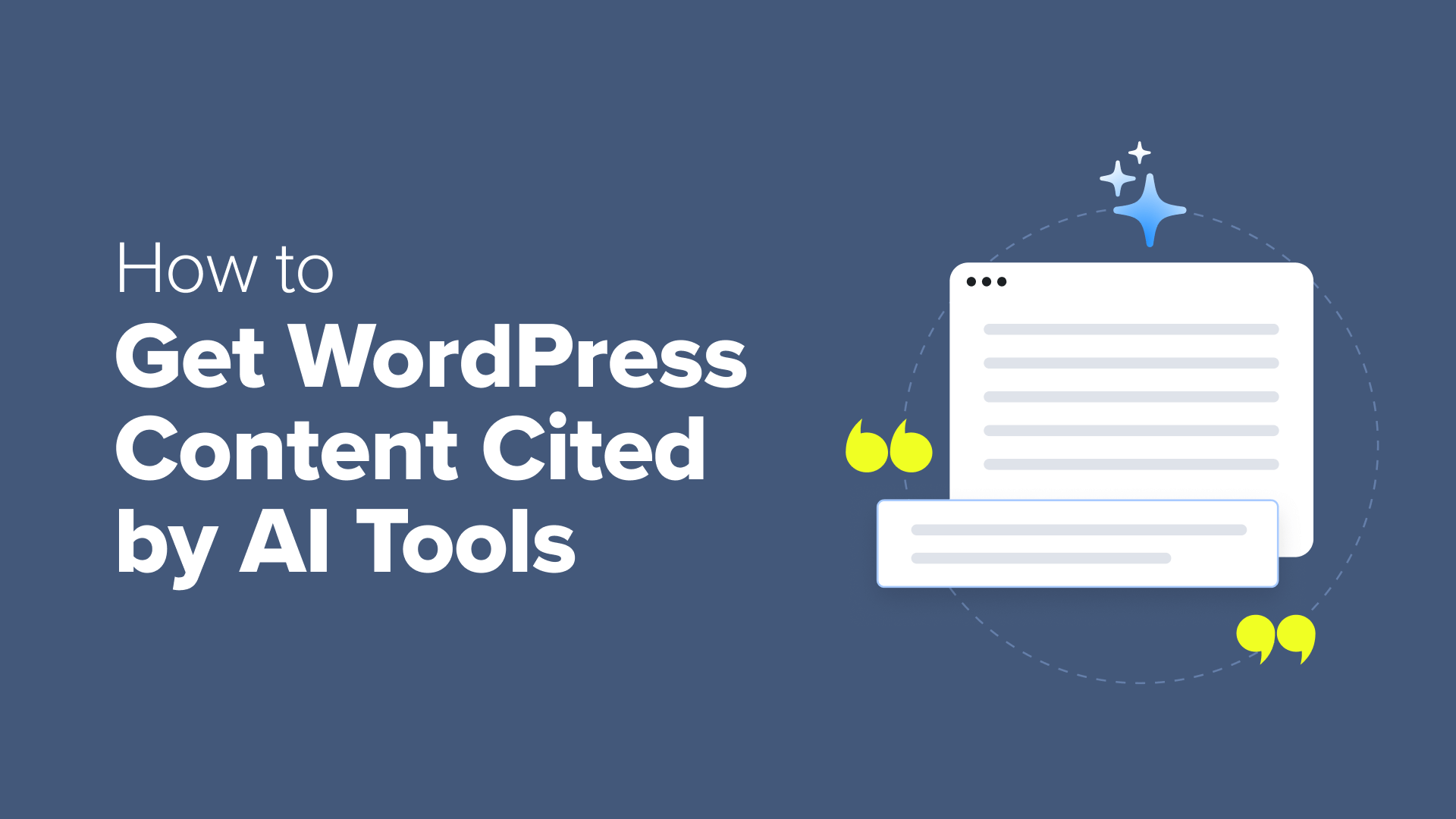
For a long time, I believed that ranking #1 on Google was the ultimate goal. But then came AI Search. Now, getting my articles cited directly in AI overviews and chat responses has become a top priority.
This is because AI is the new front page of the internet. If your business isn’t the source cited in an AI answer, then you risk becoming invisible to a growing part of your audience.
In this guide, I will walk you through the exact playbook we use on WPBeginner to get our content cited by AI tools. You’ll learn how to structure your articles to become the definitive, citable resource that AI trusts first.
In a Rush? Key Takeaways to Get Cited by AI
- Write for Absolute Clarity: Answer the user’s question immediately at the top of your article. Use simple sentences, clear headings (H2, H3), and organize data with lists and tables.
- Prove You’re an Expert (E-E-A-T): Show AI you’re a trustworthy source. Use detailed author bios, display “last updated” dates, cite authoritative sources, and share your own first-hand experience.
- Add Schema Markup: Use a WordPress SEO plugin like All in One SEO to add “schema” code. This labels your content as an FAQ, How-To guide, or Product, making it perfectly structured for AI to read and cite.
Here is a list of topics I’ll be covering in this guide:
The New SEO: Are You Being Cited by AI or Ignored?
When you ask Google a question and a detailed summary appears at the top, that’s an AI Overview. An AI Citation is when your website is credited as a source within that answer, with a direct link back to your content.
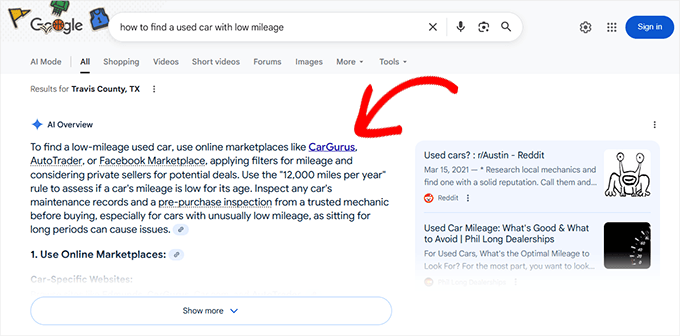
The same thing happens within top AI tools like ChatGPT, Perplexity, and Claude.
Users are asking these tools questions that they previously searched for and are now getting direct answers.
You want your content or business to become that answer.
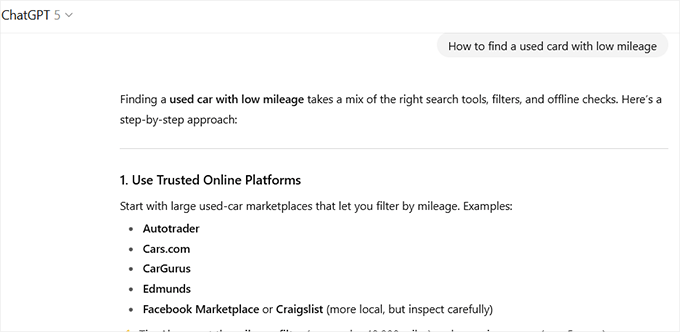
Think of it as the AI research assistant pointing to your site and saying, “This is a trustworthy source.” If you’re not getting cited, then a growing part of your audience will never know you exist.
Why This Should Be Your New Growth Strategy 🚀
Optimizing for AI isn’t just a trend. Instead, it’s a direct path to more authority and better traffic.
Here’s why it’s critical:
- Be the Answer, Not Just a Link. AI Overviews now appear in over 47% of all Google searches. Being cited puts you directly inside the answer, not just on a list below it.
- Gain Instant Authority. A citation is a powerful endorsement from Google and other AI platforms that tells users that you’re a verified, expert source.
- Capture the “Lost” Clicks. AI answers can reduce clicks to websites by up to 34.5%. A citation is your ticket to winning that traffic back from highly motivated users.
- Attract Better Visitors. Traffic from a citation isn’t random. These users have seen the summary and are clicking specifically for your deeper expertise.
In short, getting cited by AI is the new standard for proving your authority online. It’s how you win in a world where search engines don’t just find information—they answer questions directly.
How AI Tools ‘Read’ and Choose What to Cite
To get cited, you first have to understand how AI “reads.” I like to think of it like an assistant scanning a report for key facts, headings, and data tables, not like someone reading a novel for pleasure.
The AI is looking for specific signals that prove your content is reliable and easy to understand. It’s not just about being #1 on Google. It’s about being the clearest and most authoritative source within the top results.
Here’s what AI is looking for:
- Direct Answers: Clear and concise answers to specific questions.
- Structured Data: Information organized in lists, tables, and with schema markup.
- Trust Signals: Author bios, updated dates, and links to other expert sources.
- Verifiable Facts: Original data, statistics, or benchmarks that can be easily credited.
AI also thinks in terms of ‘entities.’ An entity is simply a ‘thing’ like a person, a product (like WordPress), or a concept (like SEO). Your job is to define these things clearly for the AI so that it understands what your content is about.
Part 1: Writing Citation-Friendly Content
Getting cited by AI tools starts with the words you choose. Your writing needs to be easy for a machine to digest and pull quotes from.
In my experience, this means prioritizing clarity and directness above all else. This also helps your human readers who get quick answers in an easy to understand format.
Use the ‘Answer First’ Principle
You should always provide the main answer or a summary right at the top of your article, just below the introduction.
I often put this in a styled “Key Takeaways” or a “Summary” box. This gives both human readers and AI a quick, digestible summary of the article’s most important points.
Here is how Neil Patel’s website is using Key Takeaways to provide the answer first:
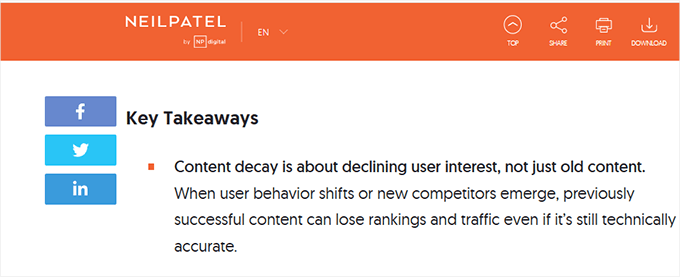
Why this works: AI models are designed for efficiency. They scan content for the most relevant information to answer a user’s query.
If you bury your conclusion at the end, you force the AI to parse the entire article, making it more likely to pull a quote from a competitor who answered the question immediately.
For example: A local contractor writing an article on “How Much Does a Deck Cost?” should answer directly at the top.
“On average, a new wood deck in our area costs between $4,000 and $11,000, or about $35 per square foot. The final price depends on materials and design complexity.”
The rest of the article can then break down those costs.
Be Direct and Simple
AI responds best to simple, declarative sentences. You should avoid complex phrasing, jargon, and passive voice to get straight to the point.
Why this works: While AI is advanced, it processes language literally. Ambiguous or overly “fluffy” sentences can be misinterpreted, causing the AI to misunderstand or completely miss the core point.
Direct language (Subject-Verb-Object) is clear and easy for a machine to parse and quote accurately.
For example:
Instead of this: “Our company’s strategic methodology is centered around the synergistic implementation of customized, client-focused solutions.” ❌
Write this: “We create custom plans to help your business succeed.” ✅
Publish Original Data
One of the most powerful ways to get cited is to be the source of original information.
When you publish unique statistics, survey results, or benchmarks from your own experience, AI has a compelling reason to credit your site.
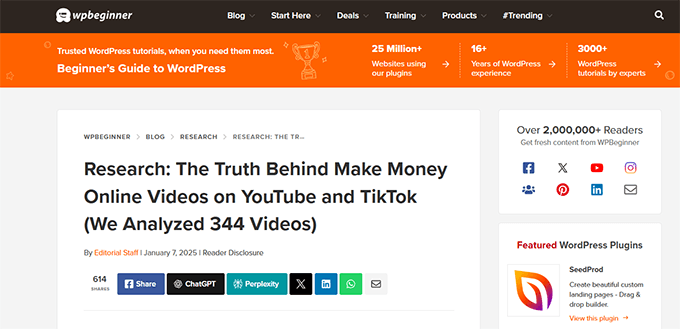
Why this works: AI models are built to find the origin of a fact. If you are the primary source for a piece of data, then you make your content a necessary citation.
This establishes authority and creates a competitive advantage that is difficult for others to replicate.
This doesn’t have to be a massive research study.
For example:
A local bakery could poll 100 customers and publish a post titled:
“We Asked 100 Locals: The Sourdough Croissant is Officially the Town’s Favorite Pastry.”
This creates a unique, citable fact that local food bloggers or news outlets might reference.
Write in ‘Self-Contained Nuggets’
You should write each major section (typically under an H2 or H3 heading) as if it could be the only thing a person reads.
This means avoiding pronouns like ‘it’ or ‘this’ when they refer to a topic from a previous section.
Why this works: AI often lifts an entire paragraph or section to use in its answer. If that “nugget” of text relies on context from a previous section, it won’t make sense on its own and will be unusable.
Making each section self-contained ensures that any piece of your content the AI pulls remains clear and valuable.
For example, on a coffee shop’s website:Instead of this ❌:H2: Our Arabica Coffee Beans…They are sourced from the highlands of Colombia, giving them a rich, smooth flavor.
Write this ✅:H2: Our Arabica Coffee Beans…Our Arabica coffee beans are sourced from the highlands of Colombia, giving them a rich, smooth flavor.
Part 2: Structuring for Success With the WordPress Block Editor
How you structure your content inside WordPress is just as important as the words you write. You can use the block editor to create a clear, AI-friendly layout that makes your content easy to understand.
Headings Are Your Roadmap
Headings are machine readable signs that provide structure to your content. They are important for traditional SEO, but they are even more significant for helping AI to understand your content.
You should use headings (H2, H3, H4) to create a logical outline for your content. This acts as a roadmap for AI, helping it understand the hierarchy and flow of your information.
Why this works: An LLM doesn’t “read” an article from top to bottom like a human. It first scans the heading structure to understand what the content covers.
A clean, logical structure allows it to instantly find the specific section that answers a user’s question, making your content a prime candidate for a citation.
✅ Good Structure Example (Financial Advisor’s Site):
- H2: Our Retirement Planning Services
- H3: For Individuals Under 40
- H3: For Pre-Retirees Over 50
❌ Bad Structure Example:
- H2: Our Services
- H2: More About What We Do For Retirement
Use the Right Blocks for the Job
The WordPress block editor already comes with powerful blocks that you can use to organize your content in an AI-Friendly format.
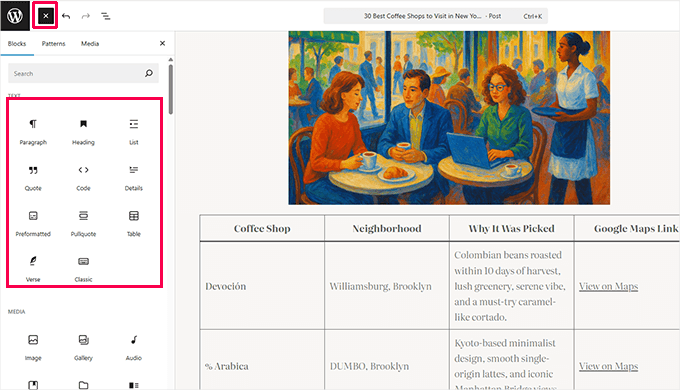
Using these specific blocks sends a clear signal to AI about what kind of information you’re presenting.
- Numbered Lists: Use these for step-by-step instructions, key takeaways, pros and cons, and more. Why: The numbered list format tells AI this is a process or sequence. It’s perfect for answering “how-to” questions, which AI loves to feature.Example: A recipe on a bakery’s blog or a tutorial on “How to Build a DIY Bookshelf” for a carpentary community.
- Bulleted Lists: These are great for highlighting features, benefits, or key points that don’t have a specific order.Why: This format signals a group of related items, making it easy for AI to pull out key features to summarize a product or service.Example: An eCommerce store listing product features like “100% Organic Cotton” and “Machine Washable.”
- Table Block: When you need to compare items directly, like pricing or features, the table block is the clearest way to present that data.Why: This is the most highly structured format for comparison. AI can easily read the rows and columns to answer questions like “Which plan has more storage?”Example: A gym’s website uses a table to compare features of its “Basic” and “Premium” membership plans.
- Quote Block: Use this to highlight key expert opinions, powerful statistics, or customer testimonials.Why: This block tells AI, “This sentence is important and directly quotable.” It draws attention to a statement you want to be known for.Example: Featuring a glowing customer review on your services page.
Include Original Visuals with Good Alt Text
Whenever possible, you should use your own original photos, charts, and screenshots instead of stock images. Then, you need to write descriptive alt text for each one.
Why this works: AI can now understand images. Alt text is a direct description that tells the AI what’s in your image and provides valuable context that reinforces your content’s topic.
A specific, descriptive alt text on an original photo is a strong signal of expertise, while a generic stock photo adds little value.
For example, a landscaping company’s portfolio:
Bad Alt Text ❌: “backyard garden”
Good Alt Text ✅: “A modern backyard garden design with a stone patio, outdoor seating, and a rectangular water feature.”
Part 3: Proving Your Expertise (E-E-A-T)
AI tools, just like Google, are being trained to prioritize content from trustworthy experts. E-E-A-T stands for Experience, Expertise, Authoritativeness, and Trustworthiness.
You need to build these signals directly into your website to prove you’re a credible source worth citing.
Set Up Your Author Bio
A complete author bio proves a real, qualified person wrote your content. In WordPress, you can easily fill this out by going to Users » Profile in your dashboard.
Now, many WordPress themes will pick up author information there and show it on your website. But often it is not SEO friendly.
To address this, I use All in One SEO’s Author SEO tab. It allows you to add more information to your author bio box and make it extremely useful in establishing credibility.
For details, see this tutorial on how to add an author info box in WordPress.
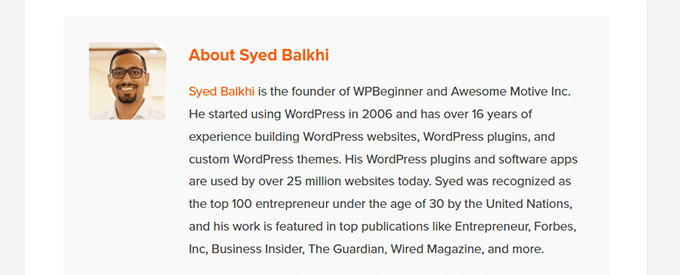
Why this works: An anonymous article has no authority. On the other hand, a detailed author bio with credentials, years of experience, and links to other professional profiles (like LinkedIn) is a powerful trust signal. It tells AI that the content isn’t just generic information; it’s advice from a credible expert.
Example of a strong bio: “Jane Doe is a Certified Financial Planner with 15 years of experience helping families navigate retirement. Her advice has been featured in Forbes and she is the author of the book ‘Your Financial Future.’ Connect with her on LinkedIn.”
Display ‘Last Updated’ Dates
Showing when your content was last updated is a very important trust signal, especially for topics that change over time.
Now this does not necessarily mean that older articles are not cited by AI’s as sources. However, for competitive search terms, content-freshness could be used by AI as a metric.
You also need to keep your most important content up to date. See our article on how to fix content decay on your website to learn more.
Why this works: A “last updated” date tells users and AI that the information is current and relevant. When faced with two articles, an AI will always prefer the one that is up-to-date. This is especially important in industries like finance, health, or marketing, where old advice can be useless or even harmful.
Cite Your Sources and Link Internally
When you mention a statistic or specific piece of data, you should link to the original, authoritative source. At the same time, you should also link to your own related guides and articles to showcase the depth of your knowledge.
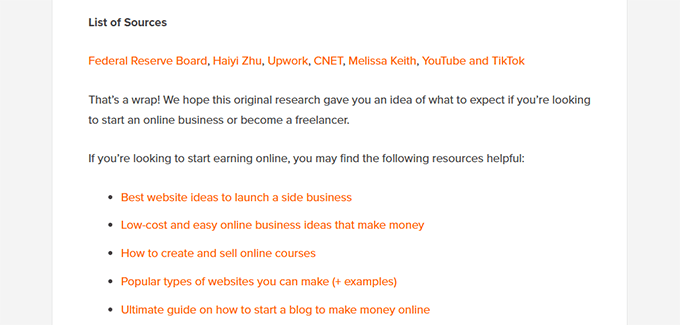
Why this works:• Linking externally to trusted sources (like university studies, government data, or industry reports) shows that your content is well-researched and fact-based. It builds your credibility by association.• Linking internally to your other content builds your “topical authority.” It signals to AI that you don’t just have one article on a subject, but a whole library of expertise. This makes your site a more reliable resource to cite.
For example: An article about “The Benefits of Organic Cotton” on an eCommerce site should link out to a scientific study on pesticide use. It should also link internally to its own product category pages for “Organic Cotton Baby Clothes” and its guide on “How to Care for Natural Fabrics.”
Use a First-Person Voice
AI has a bias for content written by subject experts or individuals rather than organizations. They believe it shows actual human experience that they can count on.
To demonstrate first-hand experience, it’s powerful to use phrases like, “In my experience …,” “I tested this and found…,” or “My team recommends…”
Why this works: This directly addresses the “Experience” part of E-E-A-T. AI is learning the difference between generic, summarized content and insights from someone with real-world experience. That’s why sharing personal case studies, results, and hands-on advice provides a strong signal of genuine expertise.
Example:
Generic content ❌: “Dog trainers suggest using positive reinforcement.”
Experience-driven content ✅: “In my 10 years as a professional dog trainer, I’ve found that positive reinforcement with clicker training is the fastest way to teach a puppy to sit.”
Part 4: The Right Plugins & Technical Settings
A few simple technical settings can make a huge difference in how AI discovers and understands your content. Thankfully, powerful SEO plugins can handle most of the heavy lifting for you.
Make Your Content AI-Ready with AIOSEO
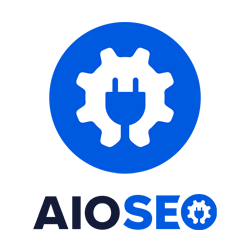
All in One SEO (AIOSEO) is the most powerful SEO plugin for WordPress, used by over 3 million websites. It makes complex SEO tasks, like adding schema markup, incredibly simple.
With just a few clicks, you can add FAQ, How-To, Product, and other schema types to your content, making it perfectly structured for AI and search engines.
Add Schema Markup with an SEO Plugin
Schema markup is code that acts like descriptive labels for search engines.
Think of your webpage as a business card. Schema is the code that labels each part, telling AI, “This is the company name,” “This is the phone number,” and “These are the opening hours.”
Why this works: AI thrives on structured data because it removes all guesswork. When you use schema for an FAQ, a recipe, or a product, you are handing the AI a perfectly organized file. This makes your content incredibly easy for it to process and use in an answer, which increases your chances of being cited.
The easiest way to add schema is with an SEO plugin like All in One SEO (AIOSEO). It includes easy-to-use blocks and settings for adding all types of schema, like FAQ and How-To for articles, Product schema for eCommerce stores, and Recipe schema for food blogs.
For more details, see our tutorial on how to add schema markup in WordPress.
Check Your AI Crawler Settings
Your website has a file called robots.txt that acts like a set of rules for bots. It’s like putting a “Staff Only” or “Welcome” sign on different doors of your business. By default, WordPress welcomes all crawlers, which is what you want.
Another new standard is the llms.txt file. Similar to the robots.txt file, it allows you to communicate specifically with AI crawlers.
You can easily add it an llms.txt file to your website using All in One SEO.
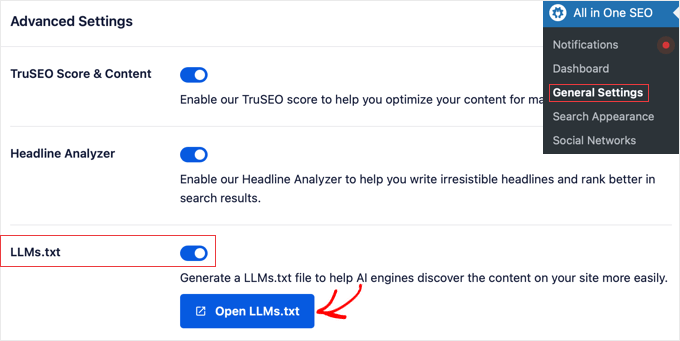
Why this works: Occasionally, a setting or a plugin might accidentally change this file, putting up a “Do Not Enter” sign for important AI bots like Google-Extended (for AI Overviews) or GPTBot (for ChatGPT). A quick check ensures your doors are wide open for these tools to find and cite your content.
Part 5: How to Know if Your Strategy is Working (Measuring Citations)
After you’ve optimized your content, you will need to know if your efforts are paying off. Tracking AI citations is a new field, but here are a few simple methods you can use to see if you’re being recognized as a source.
Manual Checks (The Free Method)
The most direct way to check for citations is to simply ask AI tools. I use this method all the time and have found it to be the easiest, no-cost way to spot-check if a brand and key content are breaking through.
How to do it: Go to tools like ChatGPT, Gemini, or Perplexity and use AI prompts that reference your brand. You can also use advanced Google searches to find mentions.
Example Prompts:• “According to [Your Brand Name], what is the best way to [do a task you wrote about]?”• “What does [Your Brand Name]’s blog say about [a specific topic]?”• You can also ask the question your article answers and see if your site is listed as a source in the footnotes.
Example Google Search:To find if a unique statistic has been mentioned, you can search for it in quotes. Using our bakery example from Part 1, you would search for: “the Sourdough Croissant is Officially the Town’s Favorite Pastry”
Automated Tracking (For Businesses)
For businesses that want to track citations at scale, new AI monitoring tools are becoming available. These services automatically scan AI responses for mentions of your brand.
Why this is useful: Manual checks are time-consuming and can miss citations. Automated tools provide consistent monitoring, save you hours of work, and can even track your competitors’ citations so you can learn what’s working for them.
Recommended Tools:
- Semrush – Offers AI Overview tracking as a feature in their SERP tracking tool.
- Otterly.ai – Offers insights into how visible your brand and website citations are on AI Search.
- GPTrends.io – See how your product is searched and mentioned in AI tools.
Your AI Citation Checklist & Conclusion
Optimizing for AI might seem new, but it’s built on the existing foundation of high-quality, user-focused content. By making your content clearer for machines, you’re almost always making it better and more helpful for your human readers, too.
Here is a simple checklist of the key actions from this guide:
- Put a clear summary or answer at the top of your post.
- Use a logical heading structure (H2, H3) to create an outline.
- Organize data with lists, tables, and quote blocks.
- Prove your expertise with a detailed author bio and updated dates.
- Use an SEO plugin to add relevant schema markup (like FAQ or HowTo).
💾 Feel free to download the more visually appealing and printable image below:
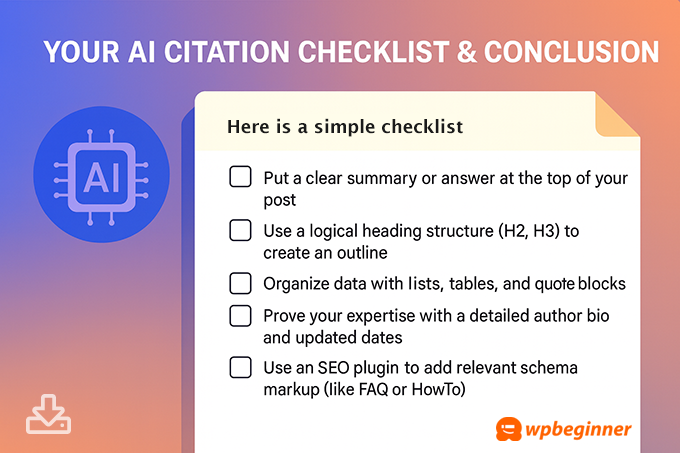
The future of online content is clear, structured, and trustworthy. By following these steps, you can position your WordPress site as a go-to authority that both users and AI will trust for years to come.
Frequently Asked Questions (FAQs) About AI Citations
How do AI tools decide what content to cite?
AI tools prioritize content from high-authority websites that ranks well in traditional search results. They look for clear, direct answers, structured data like lists and tables, and trust signals like author expertise and recent update dates.
Can structured data increase my chances of being cited by AI?
Yes, absolutely. Structured data, like schema markup for FAQs, How-To guides, and products, acts as a clear ‘label’ for AI. It helps the AI quickly understand the purpose and content of your page, making it a more attractive and reliable source to cite.
What are some best practices for making my content appealing to AI tools?
Best practices include writing simple, direct sentences, placing the main answer at the top of the article, using headings to create a logical structure, publishing original data or stats, and proving your expertise with author bios and links to authoritative sources.
Should I still optimize to rank for traditional SEO rankings?
Absolutely. Traditional SEO rankings are still important and even help you build credibility with AI platforms. Many AI platforms often pull results from search engines, which means a higher ranking may still get you mentioned in AI responses.
Additional Resources for SEO and GEO
If you liked this article, then please subscribe to our YouTube Channel for WordPress video tutorials. You can also find us on Twitter and Facebook.



